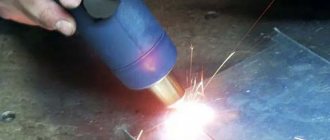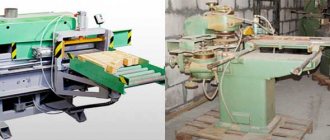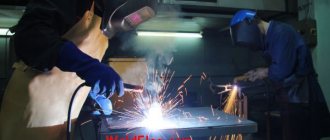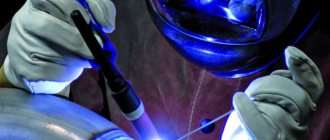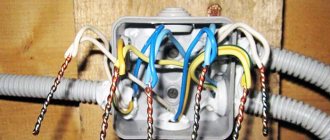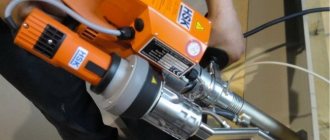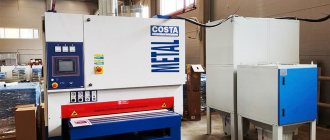Induction welding: what is it, types of welding
Recently, a very popular method of producing electric welded pipes is welding with high-frequency currents, the range of which varies from 70 to 450 kHz. High-frequency welding is used mainly in the manufacture of pipes with a diameter from 8 mm to 529 mm and a metal thickness from 0.3 mm to 10 mm.
What is welding with high frequency currents, and how does it differ from conventional MMA welding with electrodes? What welding methods exist, read this article.
What is induction welding
Induction welding of metals is a method of heat treatment of metal workpieces under pressure. Electromagnetic induction is used to heat the parts being welded. The induction coil placed in the welding machine is excited by high frequency electric current. Due to the coil, a high-frequency electromagnetic field is generated, affecting a ferromagnetic or conductive material.
Heating in workpieces made of ferromagnetic material occurs mainly under the influence of hysteresis. In workpieces made of conductive material, the main type of heating is resistive, which is caused by eddy currents.
Non-magnetic or electrically insulating materials, such as plastic, can be induction welded by placing ferromagnetic or metal mixtures into them. They are called induced current receivers because their purpose is to collect induced energy from the coil. Receivers, after heating and due to thermal conductivity, transfer heat to the material that surrounds them.
Induction welding is a work process that is highly automated. It is carried out very quickly. This is explained by the fact that a huge amount of energy can be transferred to the welding site, due to which the surfaces being joined occur in a very short time. As a result, the surfaces are quickly pressed against each other, creating a continuous weld.
The depth of penetration of induced currents depends on many factors, including the temperature and chemical composition of the metal.
DIY induction heater 500 Watt
Scheme of a 500 Watt induction heater that you can make yourself! There are many similar schemes on the Internet, but interest in them is disappearing, since mostly they either do not work or work but not as expected. This induction heater circuit is fully working, tested, and most importantly, not complicated, I think you will appreciate it!
Induction heater circuit:
Components and coil:
The working coil contains 5 turns; a copper tube with a diameter of about 1 cm was used for winding, but less is possible. This diameter was not chosen by chance; water is supplied through the tube to cool the coil and transistors.
The transistors were installed with IRFP150 since IRFP250 was not at hand. Film capacitors are 0.27 uF 160 volts, but you can put 0.33 uF and higher if you can’t find the first ones. Please note that the circuit can be powered with voltages up to 60 volts, but in this case, it is recommended to install capacitors at a voltage of 250 volts. If the circuit is powered by a voltage of up to 30 volts, then 150 will be enough!
You can install any zener diodes at 12-15 volts from 1 Watt, for example 1N5349 and the like. Diodes can be used UF4007 and the like. Resistors 470 Ohm from 2 Watts.
A few pictures:
Instead of radiators, copper plates were used, which are soldered directly to the tube, since this design uses water cooling. In my opinion, this is the most effective cooling, because the transistors heat up well and no amount of fans or super radiators will save them from overheating!
The cooling plates on the board are located in such a way that the coil tube passes through them. The plates and tube need to be soldered together; for this I used a gas torch and a large soldering iron for soldering car radiators.
The capacitors are located on two-sided PCB, the board is also soldered directly to the coil tube for better cooling.
The chokes are wound on ferrite rings, I personally took them from a computer power supply, the wire was used in copper insulation.
The induction heater turned out to be quite powerful, it melts brass and aluminum very easily, it also melts iron parts, but a little slower. Since I used IRFP150 transistors, according to the parameters, the circuit can be powered with a voltage of up to 30 volts, so the power is limited only by this factor. So I still recommend using IRFP250.
Application area
Most often, high-precision welding is used in the pipe industry. It is ideal for the production of pipes from different metals: copper, aluminum, steel. The surfaces of other hollow profiles are also connected. To give the required shape to flat metal strips, special rollers are used to guide the workpiece, which moves through the inductor.
Moreover, the induction currents move to the current point of contact, passing through both edges of the future product.
This technology is also used in the production of finned tubes, which are used to make heat exchangers. In this case, a method of high-speed sequential welding of a solid spiral fin blank to a high-carbon steel pipe is used.
How to make an induction boiler with your own hands - diagram and description
Homemade induction boiler at work
Compared to traditional heaters, an induction boiler allows you to consume electricity very economically.
In conditions when electricity is not becoming cheaper, but is becoming more expensive every year, the construction of such a boiler seems very relevant.
One of the undeniable advantages of this type of device is its environmental friendliness and safety. That is, during operation, the boiler does not release substances harmful to the body or polluting the environment into the space.
It can be fully recommended “for a healthy home.” And if you compare induction heaters with solid fuel boilers, their advantages become truly impressive.
Design and principle of operation of the boiler
Just like ordinary heating elements, boilers operating on the induction principle convert electrical energy into heat.
However, thanks to the special design, the coolant in the induction boiler heats up much faster, which directly affects the efficiency of this device.
In the simplest case, the device is an electrical inductor, in other words, a transformer that has a primary and secondary (short-circuited) winding.
The internal part generates eddy currents, which are immediately redirected to the secondary winding.
The secondary winding, in this case, is a short-circuited coil, which also acts as a housing.
The secondary winding thus receives a constant flow of energy. It converts this energy into heat and transfers it directly to the coolant, that is, water or antifreeze. It can also be many other substances: the main thing is that the coolant used has good conductivity of electric current.
Attention: In order to supply cold coolant to the induction boiler and then remove it hot, the unit should be equipped with two pipes of suitable size, in which the selected liquid will flow.
Ultimately, the operating principle of an induction boiler is as follows:
Sectional diagram
- First, the selected coolant is supplied to the heating device.
- Electricity is then supplied to the internal winding.
- When voltage appears here, energy in the form of eddy currents will be directed to the outer winding and begin to heat the core very quickly.
- After some time, the entire surface of the area will heat up, and the heat will be transferred to the coolant, which, in turn, will transfer it further.
Due to the fact that hot water is removed all the time, the system does not overheat, which makes it very reliable and safe.
Fields that heat
Another advantage is that such units do not have traditional heating surfaces, which sometimes fail at the most inopportune moment.
Also, a homemade induction boiler does not have disconnecting parts, that is, it is made from a single piece of plastic. And, as you know, simple things are more resistant to various unfavorable factors, and therefore are more reliable.
As for scale formation, this does not happen for the reason that the induction heater is virtually in a vibrating position all the time.
Step-by-step construction guide and diagram
Schematic diagram of a homemade induction boiler
Induction boilers have a simple design, so they can be assembled by anyone who knows what a wire rod looks like and has not forgotten how to use wire cutters.
First of all, you should make your task easier where possible.
In particular, it is very advisable to purchase the most inexpensive welding inverter.
It would be great if the inverter also has the ability to regulate the current. The current in a welding inverter is usually about 15 amperes, but for a homemade boiler it makes sense to use a more powerful unit.
Small fragments of stainless wire or rod will be heated in the electromagnetic field.
For example, you can choose a wire with a diameter of 7 millimeters (this diameter can be considered the most optimal). The wire should be cut into pieces about 4 or 5 centimeters long.
The heater housing is made of a plastic pipe with thick walls. The diameter of the pipe may vary, but ideally you should stock up on a plastic pipe with a diameter of just under 5 centimeters.
The device should be connected to the heating network through special adapters. Through these adapters, cold coolant will enter the boiler and also leave it, but in a heated form.
The bottom of the selected plastic pipe should be covered with a metal mesh with small cells so that wire fragments do not fall out of it. After this, the pipe is filled with pieces of wire. The top of the pipe is then covered with the exact same mesh that was used to cover the bottom.
Now you can start making the induction coil. To get this simple device, you need to tightly wrap 90 turns of wire around a plastic pipe. The wire chosen is copper, enameled. The coils should be applied very carefully. They should be located approximately in the center of the plastic pipe.
The result should be a device that can be connected to the heating system. This is done very simply. First, you need to cut out a part of the pipe from the existing pipeline, and then install an induction boiler in its place.
The coil should be connected to the inverter, after which the system can be filled with water.
This device can only be used if there is coolant in the system. The fact is that if you turn on the boiler “dry”, the plastic pipe will simply melt, which, in turn, will lead to other troubles.
It is very important to properly ground the heating device.
So, building a functioning unit for heating water with your own hands is really not at all difficult. At the same time, the materials that will be needed for this cost not only little, but sometimes their price reaches zero. Of course, after this we begin to be sincerely surprised by the prices that manufacturers today set for factory heaters.
Advantages and disadvantages
Compared to other methods of joining metals, induction welding is much more productive - 2 times. The benefits include:
- energy savings, since pre-heating of the workpiece is not required;
- reduced duration of heating cycles (reduced electricity consumption);
- high accuracy of the heating section, since the number of heating zones is reduced;
- no contact of the inductor with the part, thereby reducing the cost of maintaining the device;
- reducing the labor intensity of cleaning the finished product;
- reduction of production cycle time;
- comfortable conditions when performing work and reducing the risk of injury;
- high quality welding seams.
Disadvantages include the difficulty of maintaining a uniform gap between the workpiece and the inductor, and the difficulty of concentrating heat on the welding area. Another disadvantage is the high energy consumption.
Homemade induction heater
Craftsmen have come up with many ways to heat a house. One of them is an induction heater. Like any other, it has its advantages and disadvantages.
Operating principle
The work is based on the Joule-Lenz law, which reflects the direct dependence of the thermal output of a conductor on the electric field strength. Everyone knows the relationship between magnetism and electricity, which simply cannot exist without the other. If a high frequency current is applied to the coil, a magnetic field is formed around it. Its flow will penetrate the conductive core inserted into the coil. The resulting magnetic induction will constantly change in direction and time, which will cause the appearance of eddy currents moving in a vicious circle. And this converts electromagnetic energy into thermal energy. This is the general outline of an induction heater.
Induction heaters have proven themselves brilliantly in a wide variety of applications. With their help, you can carry out surface hardening of metal products, ultra-clean, non-contact welding, spot heating and even melting of conductive materials. Industrial inductors are equipped with a powerful transformer capable of supplying large currents to them.
Inductor in everyday life
Since the circuit of such a heater is not complicated, and the efficiency of such a device is very high (up to 98%), the vortex induction heater could not but interest craftsmen.
Very often, many people have the idea of using the induction principle to heat their home. After all, an induction heater is capable of heating water almost instantly. Therefore, there are a number of designs that represent a homemade induction heater.
There are many laws in physics that you can never get around. Energy is not taken from nowhere, and therefore the amount of electricity consumed cannot be less than the thermal energy required.
In other words, if it takes 5 kW/h to heat a room, it will not be possible to do so using only 2 kW/h of electricity, no matter how great the heater design is. If you plan to heat using an inductor, you need to be prepared to increase your electricity bills.
The most popular option among craftsmen is an induction heater made from a welding inverter. There are a number of reasons for this:
- The inverter produces current at higher frequencies, which significantly increases the electric field strength, and this has a beneficial effect on heat transfer.
- The welding inverter is capable of supplying high currents. Of all the appliances available for home use, the inverter is best suited for use as a power supply for an induction heater.
Design elements
A do-it-yourself induction heater is made as follows:
- A piece of plastic pipe with a wall thickness of at least 3 mm is filled with pieces of metal wire. Their length is approximately 5 cm.
- Both edges of this piece of pipe are covered with a metal mesh to hold these pieces in place. The pipe must be completely filled with wire.
- After this, it should be carefully wrapped with a thick copper wire - about 90 turns. It is advisable to choose a wire with a diameter of at least 3 mm.
- Using adapters and fittings, the pipe is connected to the heating system, which is then filled with water.
- The ends of the wire are connected to the terminals of the welding inverter.
- It is necessary to ensure compliance with all fire and electrical safety measures.
After turning on the device, the metal pieces of wire will instantly heat up and begin to give off heat to the water passing through them.
It is especially worth emphasizing that the water must circulate continuously.
Otherwise, the temperature of the pipe will rise so much that there is a risk of it melting.
This is one of the most serious disadvantages of such heaters. In case of frequent absence of owners, a system of automatic computer control over the operation of the heater is necessary.
An induction heater is quite suitable for heating, but it has its drawbacks. They are completely fixable, and with proper attention to detail, this design can compete with others.
Induction welding technology
Since products made of durable metals have a high level of inductive resistance, the high-frequency current does not spread around the perimeter, as a result of which the pipes are compressed and welded. The workpieces are connected when they are placed in the inductor. At the moment when the parts to be welded are placed in the inductor, eddy currents are induced at the joint areas, which have the opposite direction to the relative current placed in the inductor.
Passing currents get in the way of the connection gap, and they move towards it. The concentration of current is concentrated mainly on the parts of the surface to be welded, and the metal is quickly heated to the required temperature, which is optimal for welding.
Induction heater from a welding inverter
In the eighties, scientists first created an induction heater, which is now actively used in the everyday life of millions of people.
With electricity prices rising every year, we can't help but wonder about ways to save money. One such method is an induction metal heater from a welding inverter
Induction heater MiniDuctor-2
An induction heater from a welding inverter - a diagram of its use and creation will help reduce your energy costs. What are the advantages of using it? How to make an induction heater from a welding inverter with your own hands? You will find the answer to these and other questions in this article.
Savings, truth or myth?
There are two opinions regarding savings on using an induction heater at home. One side believes that he is really able to preserve the contents of the wallet, while others believe that this is just another way to lure buyers. Both sides provide scientific arguments for their positions.
Proponents that induction heating with a welding inverter cannot lead to any savings refer to the law of conservation of energy. According to him, no matter which heater a certain amount of energy is supplied to, for example, 12 kW, it will not be able to generate more thermal energy due to losses and the lack of 100% efficiency.
Thus, they dispute the fact that an induction heater can bring big savings in the budget.
Opponents of this opinion emphasize that while receiving energy at the same 12 kW, the induction heater produces less energy, however, not all of this energy is thermal. Moreover, thermal energy is generated to a greater extent than is obtained.
Welding inverter Brigadier
Induction heater device
An induction heater differs from a standard electric heating boiler and promotes faster heating, which is indispensable in cold weather.
However, in their design they have the general principle of converting electrical energy into thermal energy.
So, the boiler is a transformer with primary and secondary windings. The secondary is a kind of housing made of short-circuited turns. That is, there is always energy on it, and it is this that is processed into heat, and because of it, antifreeze or water is heated, it is not necessary to use these particular substances, others are also acceptable, the main condition is their ability to conduct current.
Operating principle of a homemade induction heater
Thus, the induction heater from the inverter has the following principles in its operation:
- the coolant is supplied to the heating device,
- electric current is supplied to the second winding,
- the greatest heating of the core is provided by voltage, which leads to the excitation of eddy currents directed to the internal winding,
- after the entire area is heated, the remaining heat passes into the coolant, which ensures a favorable climate.
How to make an induction heater with your own hands from a welding inverter?
It is very difficult to create an induction heater from a welding inverter, but it is possible.
First you need to ensure the presence of electromagnetic current. The easiest way to create it is to place a pipe in an induction coil. Based on the conductivity of currents, it should be metal, however, due to the small coolant, it will not be able to heat the coolant as much as possible. Therefore, it is recommended to use a polymer pipe. Next, it will need to be filled with scraps of metal wire. However, if this method is difficult for you, you can also use a coil, however, for the best result, it should have a large number of turns in the form of a coil.
Induction heater from a welding inverter
Now we need to provide a current generator. It is best to use an inverter arc welding machine for this job.
So let's start creating. First you need to cut the wire rod (preferably steel) so that you get cylinders of different sizes from 4 to 6 mm.
We close one side of the pipe with a fine mesh. We put pieces of wire inside. After which the mesh is placed on the other side.
We make an induction winding around the pipe using copper wire. It is needed as a heater. The approximate number of turns on the winding should be about eighty-five or ninety-five. Their ends must be carefully insulated and connected to the inverter output.
That's all, the DIY induction heater from a welding inverter is ready.
But how will it work? In fact, the principle of its operation is quite simple. When the welding machine is turned on, an electromagnetic field will be created using a coil. This will serve as a base that will cause eddy currents. The core will heat up, due to which the water flowing through the pipe will heat up.
Induction heater from a welding inverter - the creation scheme is based on the basic laws of physics, and works quite effectively at home, and requires compliance with safety regulations.
DIY metal induction heater
You can also create an induction metal heater from a welding inverter yourself. Basically, you have to weld two pipes into each other. One of them will act as a core, and the other will act as a heater.
The DIY metal induction heater circuit consists of wrapping a wire with a diameter of about 1.5 mm around the body. The number of turns depends on the diameter of the housing and the desired result.
Simple induction heater
Next you need to weld two pipes into the body.
It is recommended to make an insulator for the resulting heater. It is needed to retain the maximum amount of heat.
Thus, the DIY metal induction heater circuit is quite complex, but can be done at home.
Induction heater design diagram
However, when creating induction heaters, it is worth remembering an important factor: safety precautions. By not following safety precautions when using or making an induction heater, you are putting the lives of your loved ones and yourself at risk. A set of easy-to-follow rules will help you maximize the comfort and safety of your life.
Equipment and materials
Any equipment for induction welding, regardless of purpose, consists of the following elements:
- inductor (current conductor);
- HDTV power supply;
- welding head with high frequency transformer and capacitor bank;
- technological equipment for fixing workpieces;
- device for creating pressure.
Induction welding is used to ensure maximum accuracy and cleanliness of welded workpieces necessary for production, installation, and repair work. The use of this equipment allows you to carry out work in the shortest possible time. Models of welding machines are produced in different capacities, design features, current frequency, price, operating voltage and other criteria.
Contact method
The most common method of producing electric-welded pipes is the option using a contact current conductor, due to the concentrated release of heat in the welding zone. Using this scheme allows you to use energy more economically and increase the list of welded products.
But it also has its drawbacks. These include the fragility of the contact element and its low wear resistance, which depends on a number of reasons such as:
- contact material;
- method of cooling it;
- degree of pressure and current strength.
This also includes welding with a rotating contact transformer.
You can find out how to make such a machine for resistance welding on the website. The device itself consists of:
- pipes;
- sliding contacts;
- core;
- crimping rollers.
